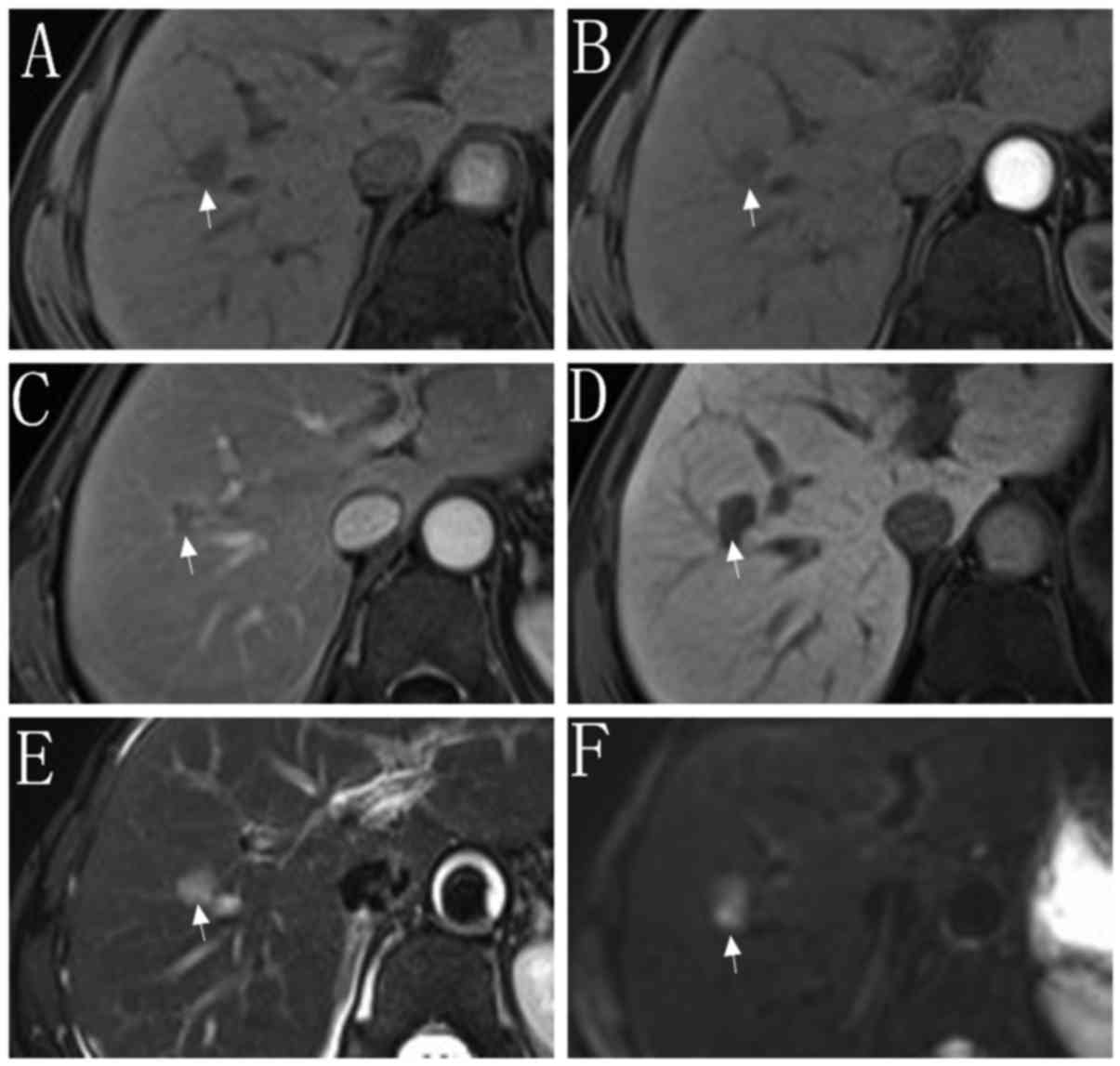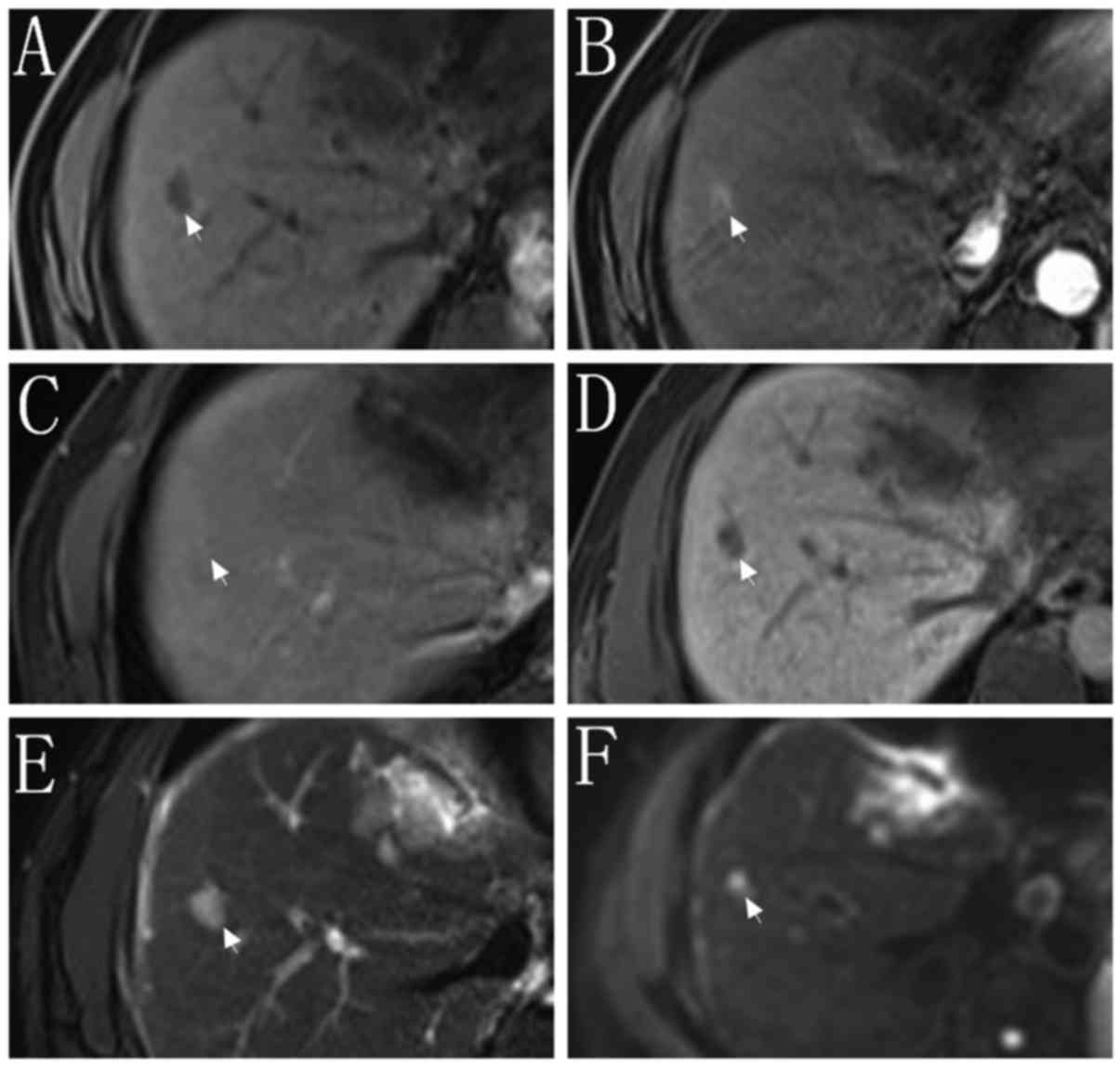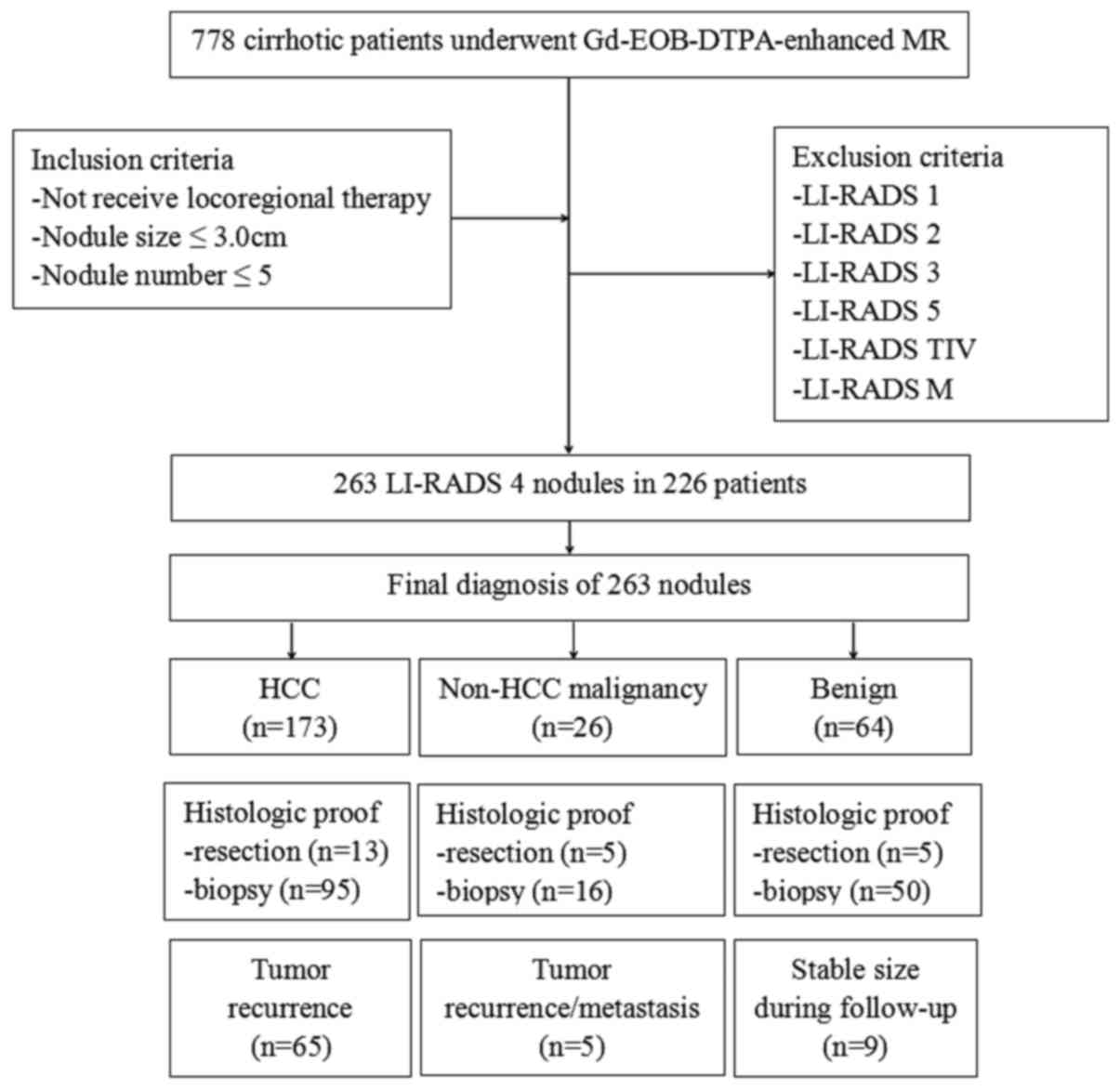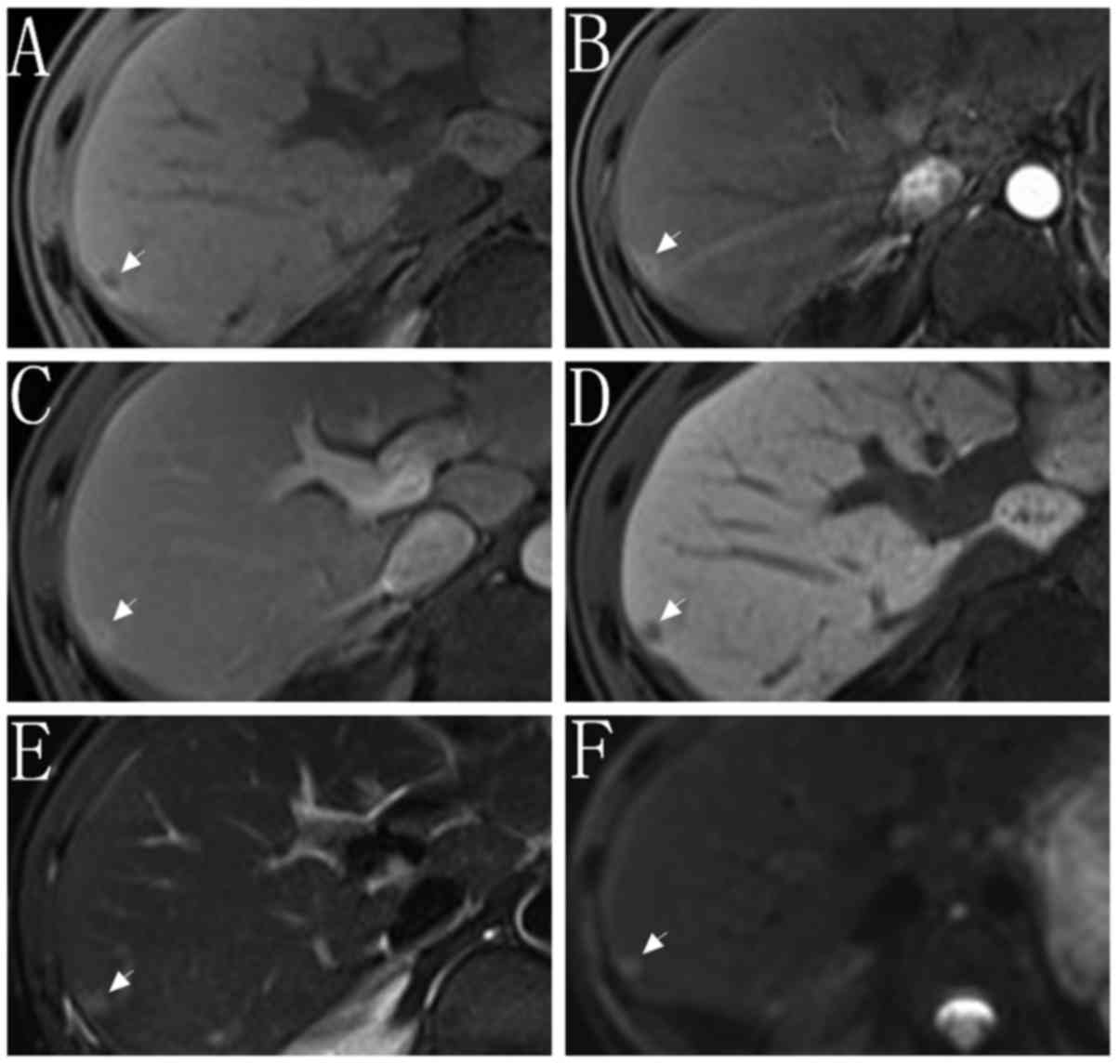|
1
|
Purysko AS, Remer EM, Coppa CP, Leao HM,
Thupili CR and Veniero JC: LI-RADS: A case-based review of the new
categorization of liver findings in patients with end-stage liver
disease. Radiographics. 32:1977–1995. 2012. View Article : Google Scholar : PubMed/NCBI
|
|
2
|
Wallace MC, Preen D, Jeffrey GP and Adams
LA: The evolving epidemiology of hepatocellular carcinoma: A global
perspective. Expert Rev Gastroenterol Hepatol. 9:765–779.
2015.PubMed/NCBI
|
|
3
|
Yan M, Ha J, Aguilar M, Bhuket T, Liu B,
Gish RG, Cheung R and Wong RJ: Birth cohort-specific disparities in
hepatocellular carcinoma stage at diagnosis, treatment, and
long-term survival. J Hepatol. 64:326–332. 2016. View Article : Google Scholar : PubMed/NCBI
|
|
4
|
Goldberg DS, Valderrama A, Kamalakar R,
Sansgiry SS, Babajanyan S and Lewis JD: Hepatocellular carcinoma
surveillance among cirrhotic patients with commercial health
insurance. J Clin Gastroenterol. 50:258–265. 2016. View Article : Google Scholar : PubMed/NCBI
|
|
5
|
Bruix J and Sherman M: Management of
hepatocellular carcinoma: An update. Hepatology. 53:1020–1022.
2011. View Article : Google Scholar : PubMed/NCBI
|
|
6
|
Davenport MS, Khalatbari S, Liu PS,
Maturen KE, Kaza RK, Wasnik AP, Al-Hawary MM, Glazer DI, Stein EB,
Patel J, et al: Repeatability of diagnostic features and scoring
systems for hepatocellular carcinoma by using MR imaging.
Radiology. 272:132–142. 2014. View Article : Google Scholar : PubMed/NCBI
|
|
7
|
Leoni S, Piscaglia F, Golfieri R, Camaggi
V, Vidili G, Pini P and Bolondi L: The impact of vascular and
nonvascular findings on the noninvasive diagnosis of small
hepatocellular carcinoma based on the EASL and AASLD criteria. Am J
Gastroenterol. 105:599–609. 2010. View Article : Google Scholar : PubMed/NCBI
|
|
8
|
Khalili K, Kim TK, Jang HJ, Haider MA,
Khan L, Guindi M and Sherman M: Optimization of imaging diagnosis
of 1–2 cm hepatocellular carcinoma: An analysis of diagnostic
performance and resource utilization. J Hepatol. 54:723–728. 2011.
View Article : Google Scholar : PubMed/NCBI
|
|
9
|
Santillan C, Chernyak V and Sirlin C:
LI-RADS categories: Concepts, definitions, and criteria. Abdom
Radiol (NY). 43:101–110. 2018. View Article : Google Scholar : PubMed/NCBI
|
|
10
|
Santillan C, Fowler K, Kono Y and Chernyak
V: LI-RADS major features: CT, MRI with extracellular agents, and
MRI with hepatobiliary agents. Abdom Radiol (NY). 43:75–81. 2018.
View Article : Google Scholar : PubMed/NCBI
|
|
11
|
Cha DI, Jang KM, Kim SH, Kang TW and Song
KD: Liver imaging reporting and data system on CT and gadoxetic
acid-enhanced MRI with diffusion-weighted imaging. Eur Radiol.
27:4394–4405. 2017. View Article : Google Scholar : PubMed/NCBI
|
|
12
|
Granata V, Fusco R, Avallone A, Catalano
O, Filice F, Leongito M, Palaia R, Izzo F and Petrillo A: Major and
ancillary magnetic resonance features of LI-RADS to assess HCC: An
overview and update. Infect Agent Cancer. 12:232017. View Article : Google Scholar : PubMed/NCBI
|
|
13
|
Chen NX, Motosugi U, Morisaka H, Ichikawa
S, Sano K, Ichikawa T Matsuda M, Fujii H and Onishi H: Added value
of a gadoxetic acid-enhanced hepatocyte-phase image to the LI-RADS
system for diagnosing hepatocellular carcinoma. Magn Reson Med Sci.
15:49–59. 2016. View Article : Google Scholar : PubMed/NCBI
|
|
14
|
Abd Alkhalik Basha M, Abd El, Aziz El,
Sammak D and El Sammak AA: Diagnostic efficacy of the liver
imaging-reporting and data system (LI-RADS) with CT imaging in
categorising small nodules (10–20 mm) detected in the cirrhotic
liver at screening ultrasound. Clin Radiol. 72:901.e1–901.e11.
2017. View Article : Google Scholar
|
|
15
|
Mitchell DG, Bruix J, Sherman M and Sirlin
CB: LI-RADS (Liver Imaging Reporting and Data System): Summary,
discussion, and consensus of the LI-RADS management working group
and future directions. Hepatology. 61:1056–1065. 2015. View Article : Google Scholar : PubMed/NCBI
|
|
16
|
Santillan CS, Tang A, Cruite I, Shah A and
Sirlin CB: Understanding LI-RADS: A primer for practical use. Magn
Reson Imaging Clin N Am. 22:337–352. 2014. View Article : Google Scholar : PubMed/NCBI
|
|
17
|
Elsayes KM, Hooker JC, Agrons MM, Kielar
AZ, Tang A, Fowler KJ, Chernyak V, Bashir MR, Kono Y, Do RK, et al:
2017 Version of LI-RADS for CT and MR Imaging: An Update.
Radiographics. 37:1994–2017. 2017. View Article : Google Scholar : PubMed/NCBI
|
|
18
|
Qian H, Li S, Ji M and Lin G: MRI
characteristics for the differential diagnosis of benign and
malignant small solitary hypovascular hepatic nodules. Eur J
Gastroen Hepat. 28:749–756. 2016. View Article : Google Scholar
|
|
19
|
Joo I, Lee JM, Lee SM, Lee JS, Park JY and
Han JK: Diagnostic accuracy of liver imaging reporting and data
system (LI-RADS) v2014 for intrahepatic mass-forming
cholangiocarcinomas in patients with chronic liver disease on
gadoxetic acid-enhanced MRI. J Magn Reson Imaging. 76:1330–1338.
2016. View Article : Google Scholar
|
|
20
|
Motosugi U, Ichikawa T, Onohara K, Sou H,
Sano K, Muhi A and Araki T: Distinguishing hepatic metastasis from
hemangioma using gadoxetic acid-enhanced magnetic resonance
imaging. Invest Radiol. 46:359–365. 2011. View Article : Google Scholar : PubMed/NCBI
|
|
21
|
Darnell A, Forner A, Rimola J, Reig M,
Garcia-Criado A, Ayuso C and Bruix J: Liver imaging reporting and
data system with MR imaging: Evaluation in nodules 20 mm or smaller
detected in cirrhosis at screening US. Radiology. 275:698–707.
2015. View Article : Google Scholar : PubMed/NCBI
|
|
22
|
Di Pietropaolo M, Briani C, Federici GF,
Marignani M, Begini P, Delle Fave G and Iannicelli E: Comparison of
diffusion-weighted imaging and gadoxetic acid-enhanced MR images in
the evaluation of hepatocellular carcinoma and hypovascular
hepatocellular nodules. Clin Imag. 39:468–475. 2015. View Article : Google Scholar
|
|
23
|
Motosugi U, Bannas P, Sano K and Reeder
SB: Hepatobiliary MR contrast agents in hypovascular hepatocellular
carcinoma. J Magn Reson Imaging. 41:251–265. 2015. View Article : Google Scholar : PubMed/NCBI
|
|
24
|
Ichikawa S, Ichikawa T, Motosugi U, Sano
K, Morisaka H, Enomoto N, Matsuda M, Fujii H and Araki T: Presence
of a hypovascular hepatic nodule showing hypointensity on
hepatocyte-phase image is a risk factor for hypervascular
hepatocellular carcinoma. J Magn Reson Imaging. 39:293–297. 2014.
View Article : Google Scholar : PubMed/NCBI
|
|
25
|
Golfieri R, Renzulli M, Lucidi V, Corcioni
B, Trevisani F and Bolondi L: Contribution of the hepatobiliary
phase of Gd-EOB-DTPA-enhanced MRI to dynamic MRI in the detection
of hypovascular small (<=2 cm) HCC in cirrhosis. Eur Radiol.
21:1233–1242. 2011. View Article : Google Scholar : PubMed/NCBI
|
|
26
|
Quaia E, de Paoli L, Pizzolato R, Angileri
R, Pantano E, Degrassi F, Ukmar M and Cova MA: Predictors of
dysplastic nodule diagnosis in patients with liver cirrhosis on
unenhanced and gadobenate dimeglumine-enhanced MRI with dynamic and
hepatobiliary phase. AJR Am J Roentgenol. 200:553–562. 2013.
View Article : Google Scholar : PubMed/NCBI
|
|
27
|
Kang Y, Lee JM, Kim SH, Han JK and Choi
BI: Intrahepatic mass-forming cholangiocarcinoma: Enhancement
patterns on gadoxetic acid-enhanced MR images. Radiology.
264:751–760. 2012. View Article : Google Scholar : PubMed/NCBI
|
|
28
|
Xu J, Igarashi S, Sasaki M, Matsubara T,
Yoneda N, Kozaka K, Ikeda H, Kim J, Yu E, Matsui O, et al:
Intrahepatic cholangiocarcinomas in cirrhosis are hypervascular in
comparison with those in normal livers. Liver Int. 32:1156–1164.
2012. View Article : Google Scholar : PubMed/NCBI
|
|
29
|
Rimola J, Forner A, Reig M, Vilana R, de
Lope CR, Ayuso C and Bruix J: Cholangiocarcinoma in cirrhosis:
Absence of contrast washout in delayed phases by magnetic resonance
imaging avoids misdiagnosis of hepatocellular carcinoma.
Hepatology. 50:791–798. 2009. View Article : Google Scholar : PubMed/NCBI
|
|
30
|
Joo I, Lee JM, Lee DH, Jeon JH, Han JK and
Choi BI: Noninvasive diagnosis of hepatocellular carcinoma on
gadoxetic acid-enhanced MRI: Can hypointensity on the hepatobiliary
phase be used as an alternative to washout? Eur Radiol.
25:2859–2868. 2015. View Article : Google Scholar : PubMed/NCBI
|
|
31
|
Loyer EM, Chin H, DuBrow RA, David CL,
Eftekhari F and Charnsangavej C: Hepatocellular carcinoma and
intrahepatic peripheral cholangiocarcinoma: Enhancement patterns
with quadruple phase helical CT-a comparative study. Radiology.
212:866–875. 1999. View Article : Google Scholar : PubMed/NCBI
|
|
32
|
Goshima S, Kanematsu M, Kondo H, Yokoyama
R, Kajita K, Tsuge Y, Shiratori Y, Onozuka M and Moriyama N:
Hepatic hemangioma: Correlation of enhancement types with
diffusion-weighted MR findings and apparent diffusion coefficients.
Eur J Radiol. 70:325–330. 2009. View Article : Google Scholar : PubMed/NCBI
|
|
33
|
Tateyama A, Fukukura Y, Takumi K, Shindo
T, Kumagae Y and Nakamura F: Hepatic hemangiomas: factors
associated with pseudo washout sign on Gd-EOB-DTPA-enhanced MR
imaging. Magn Reson Med Sci. 15:73–82. 2016. View Article : Google Scholar : PubMed/NCBI
|
|
34
|
Kim B, Byun JH, Kim HJ, Won HJ, Kim SY,
Shin YM and Kim PN: Enhancement patterns and pseudo-washout of
hepatic haemangiomas on gadoxetate disodium-enhanced liver MRI. Eur
Radiol. 26:191–198. 2016. View Article : Google Scholar : PubMed/NCBI
|
|
35
|
Grazioli L, Ambrosini R, Frittoli B,
Grazioli M and Morone M: Primary benign liver lesions. Eur J
Radiol. 95:378–398. 2017. View Article : Google Scholar : PubMed/NCBI
|
|
36
|
Kumar R and Indrayan A: Receiver operating
characteristic (ROC) curve for medical researchers. Indian Pediatr.
48:277–287. 2011. View Article : Google Scholar : PubMed/NCBI
|


















